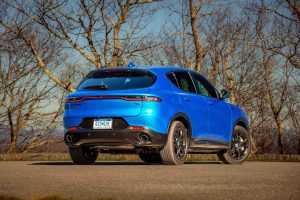When people hear Dodge, their thoughts turn to muscular cars like the Charger and Challenger. And muscular SUVs, like the Durango (especially the V8-powered R/T version).
But the government is making it hard for Dodge to continue making such cars – and SUVs. The Charger and Challenger have already been retired – and not on account of lack of popular demand. The V8 Durango is probably next.
So, what’s left?
Well, something different – that’s trying to be similar.
The Hornet is Dodge’s newest model and a very different model from other Dodge models like the Challenger and Charger (RIP).
It is a muscular crossover.
While it doesn’t have a V8, it does come standard with the most powerful engine in the class – and for the money. It’s also closely related to an Italian exotic, the Alfa Romeo Tonale (which costs a lot more money).
A new Hornet starts at $30,735 for the base GT trim – which comes standard with a 268 horsepower, 2.0 liter turbocharged engined paired up with a nine speed automatic transmission and all-wheel-drive.
That’s about $12k less to start than the Tonale – which stickers for $42,995 to start. The more expensive Tonale comes standard with a plug-in hybrid drivetrain and a smaller (1.3 liter) engine that makes 288 horsepower – and it can be driven about 30 miles on battery power alone when fully charged up.
This same plug-in hybrid drivetrain comes standard in the R/T version of the Hornet – which stickers for $40,935 to start.
What’s Good
Personality (and power) that’s sorely lacking in the $30k-or-so crossover class.
More practical than most small crossovers in its class.
Choice of drivetrains.
What’s Not So Good
The price of power is thirst (21 city, 29 highway with the standard 2.0 liter engine).
Plug-in hybrid version’s cost to buy is probably too high to save you money via spending less on gas.
The Hornet comes standard with a bigger engine than its Italian Job sibling, the Tonale – which is an interesting juxtaposition given the Italian Job costs so much more to start.
The reason why the Tonale comes only with the plug-hybrid drivetrain probably has to do with the situation in Europe – where most Tonales are sold. Over there, gas costs 2-3 times as much as it does here and there are stricter regulations limiting or even forbidding the driving of cars that burn gas in certain areas.
Because the Tonale hybrid (and the hybrid version of the American Job) can be driven about 30 miles on electricity, it can go where electric cars only are allowed. And because it does not have to be plugged in to go farther than 30 miles, it can be driven anywhere else without worrying about the battery pack running out of charge.
Dodge claims 77 MPGe – when you’re running on battery power. But when you’re out of battery power – and the engine is running to charge up the battery – you’re looking at about 26 MPG (sans the “e”).
But the real story here is the drivetrain you can’t get in the Italian Job.
The Hornet’s standard 2.0 liter, 268 horsepower engine is not only larger than the Tonale’s standard 1.3 liter engine, it is larger – and much stronger – than what comes standard in similarly sized and similarly priced small crossovers such as the Honda CR-V (1.5 liters, 190 hp) and Kia Niro hybrid (1.6 liters, 139 horsepower).
In fact, there is no other crossover available for about $30k that packs anything close to the Hornet’s punch.
Or is it sting?
To get close, you’d need to step up to something like the BMW X1 – which comes standard with a 2.0 liter turbo’d four that makes 241 horsepower. That’ll cost you $38,600. The sporty Mercedes GLC comes standard with a mild-hybrid set-up and 255 horsepower from its 2.0 liter turbo’d four.
It’ll set you back $47,450.
Meanwhile, you could be set back in your seat – by the Hornet – for just over $30k.
The American Job can get to 60 in just over 6 seconds, which is 2-3 seconds quicker than other small crossovers in its price range and on par with luxury-brand crossovers that cost thousands more.
It’s not as quick as a V8-powered Charger or Challenger, of course. But as fun as those cars are, they are not very practical cars – being rear-drive and low to the ground. They are very muscular cars.
But not snow-day cars.
The Hornet is a muscular crossover that is ready for snow days. It comes standard with 8 inches of ground clearance (vs. 5.2 for the Challenger) and standard AWD. It might not get to 60 in less than 4 seconds – like a Hellcat Challenger could. But it can get through snow like no Challenger could.
There is price to be paid for the Hornet’s performance, of course. It manifests in what you’ll be spending on gas to have some fun – as opposed to just getting where you were going. The Hornet’s mileage – 21 city, 29 highway – is below what you’d see in a CR-V (28 city, 34 highway) and well below what you’d see in a Niro hybrid (53 city, 54 highway).
But – paraphrasing Dr. Strangelove – it’s kind of the point of the thing. If you are wanting mileage rather than fun, the Hornet isn’t for you. It is for those who want something more than just good gas mileage.
And that, by the way, includes something else.
The Hornet can tow a 2,000 lb. trailer – which is 1,000 lbs. more than the Niro is rated to pull and 500 lbs. more than the Honda CR-V is rated to pull.
Also, the Hornet comes standard with an automatic transmission (a nine speed with the 2.0 engine and a six speed with the 1.3 liter engine) rather than a CVT transmission. The latter type of transmission is common in the class – chiefly because CVTs help squeak out a couple or three extra MPGs vs. an automatic that shifts through gears rather than varies through ranges.
The price you pay for the CVT’s slight gas mileage advantage is mushy-feeling (and sometimes, noisy) acceleration as well as a historically higher tendency to fail.
On The Road
There are so many crossovers out there it’s hard to tell one from the other – in terms of how they drive as well as how they look. They are as the same as generic brand aspirin. Not that there’s anything wrong with aspirin. If it cures your headache, it did its job. One aspirin being just as good for that job as any other.
The American Job cures something else.
It’s not a Charger or Challenger R/T, of course. But then, what is? The point is it’s not just another crossover – like pretty much all of the rest of them. Certainly all of the rest of them – for what you pay for them. Including a few that make you pay more for them.
The Hornet does its best to continue the tradition of the muscular Dodges that Dodge has had to take off the market. Though it is a completely different kind of vehicle – small crossover rather than hulking muscle car; small turbocharged engine rather than rumble V8 engine – it has similar attitude. Like its force-retired stablemates, it’s pugnacious relative to the typical crossover appliance. It has more power than you need – and that is good in the same way the V8 Challenger and Charger were.
You do not buy the Hornet because you need an appliance. That is what all the others are for. You buy it because you can’t buy a Charger or a Challenger, anymore.
And even if you could, there’s reason to buy this crossover manifestation of what makes Dodges something other than what everyone else is making. It is practical in a way that its V8/RWD siblings weren’t – and not just because it’s good in the snow, as they weren’t.
Because it is a crossover.
And because it is, you can use it to cart home things like a new tool box – the four-foot wide by six feet tall kind – that I hauled home using the Hornet to do just exactly that.
It’s hard to make a crossover look like something that isn’t an appliance – without being at odds with the practicality of the crossover layout. The roofline can’t be too low – or abruptly tapering. If they are, rearseat headroom and cargo room are compromised and now you have something with four doors that might as well just have two.
But – again – Dodge tries.
The Hornet has a set of recessed air vents on either side of of its hood that suggest there’s something under the hood worth taking a look at. There are large “hornet” badges on each front fender that are cockily rendered in the finest Dodge tradition.
The front end bears a family resemblance to the Charger you can no longer get.
Similarly inside.The instrument cluster looks like the Charger’s – and there’s a Performance Pages app you can call up on the LCD touchscreen, too. It’s not as braggadocious as the Performance Pages app that was included with the R/T versions of the Charger and Challenger – there’s no real-time engine dyno (horsepower and torque produced) or quarter-mile/0-60 time displays. But it’s more than you’d get in most appliances.
The same’s true of the space available for cargo behind the rear seats. The Dodge has 27 cubic feet – substantially more than the Kia Niro’s 22.8 cubic feet. If you fold the Niro’s backseats forward, the Kia has more total space (63.7 cubic feet vs. 54.7 cubic feet for the Hornet) but to get it, you must fold the backseats down. The Dodge has a lot of cargo space available without needing to fold the backseats down. To be precise, it has about 40 percent more cargo space than a Charger, which only has a 16.7 cubic foot trunk.
And which is a much larger car (198.4 inches long vs.178 inches long for the Hornet).
Usually, the R/T designation means a higher-performance version of a given Dodge model, as for example the optional V8 rather than standard V6) R/T versions of the Charger and Challenger. In this case of the Hornet, it means a higher-performance hybrid. And not just the horsepower. The package also includes high-performance Brembo bakes and a larger (18 vs. 17 inch) wheel/tire package. Also bundled in are heated seats and steering wheel.
These latter are available as options with the GT – along with a 14 speaker Harman Kardon audio system, wireless phone charger and navigation.
A Track Pack is available for the R/T that swaps out the 18 inch wheels for a 20 inch set and adds an adjustable suspension system, sport steering wheel and red powder-coated brake calipers at all four corners.
The Rest
My test drive was cut short by a low-on-charge battery – and because it’s no longer as simple as it was to trickle charge (or remove/replace) a low-on-charge battery. If you disconnect the battery (or it just goes entirely dead) the computer may think you’re trying to steal the car when you hook the battery back up.
If that happens, you may not be able to drive the car – which won’t start (but not because of the battery) but will honk the horn obnoxiously, until you follow the prescribed ritual to get the computer to calm down.
The Bottom Line
Sometimes, you do the best you can with what you’ve got. And that’s just exactly what Dodge has done here.
. . .
If you like what you’ve found here please consider supporting EPautos.
We depend on you to keep the wheels turning!
Our donate button is here.
If you prefer not to use PayPal, our mailing address is:
EPautos
721 Hummingbird Lane SE
Copper Hill, VA 24079
PS: Get an EPautos magnet or sticker or coaster in return for a $20 or more one-time donation or a $10 or more monthly recurring donation. (Please be sure to tell us you want a magnet or sticker or coaster – and also, provide an address, so we know where to mail the thing!)
If you like items like the Keeeeeeev T shirt pictured below, you can find that and more at the EPautos store!
















https://www.zerohedge.com/markets/here-are-top-five-slowest-selling-new-cars
Zach Shefska from online automotive marketplace CarEdge revealed a list of the five slowest-selling vehicles currently on the market.
#2 Dodge Hornet
517 days supply
$39,931 average listing price
10,781 actively listed for sale
939 have sold in the last 45 days pic.twitter.com/1yI1RZszuD
Hi Dan,
I think the issue with the Hornet is it’s a Dodge. And Dodge customers want Chargers and Challengers. The Hornet is a decent little crossover with some pep, but as a consolation prize for the Charger/Challenger? Forget about it!
You may be right on that. Dodge had created a reputation for themself of scat packs, demons, venoms.
Real, badass cars. The HEMI was back and they were definitely different than all the rest.
Even Camaros & Mustangs “seemed” tame beside a Challenger.
Really? 40 grand for that thing?
Defective Dodge Hornet……..
but their advertising says……….”Extra care in engineering” at Chrysler.
Ad copywriters sound good, but they don’t produce cars.
By “extra care” they mean DEI hires.
Pay $40,000 Plus tax, title, license. Then in 7-9 years replace the battery pack probably $4-8,000 (who knows the inflated figure at that time). Wondering if t can be driven with a bad battery pack. Many plug-ins cannot. Gee,,, sure is nice it can be driven downtown! Surely everyone realizes these too will be outlawed by the scammers at some point.
Gotta be THE most stupid thing I can recollect in my lifetime especially over a harmless gas that all life depends on. People are buying this junk on 7 yr loans. Pay it off only to encounter another loan to replace battery pack. In 8 years with the original battery pack can you imagine the trade in value!
Do people just want to be scammed? It seems so… Stupid is as Stupid does.
VW e-Golf Battery Replacement Cost
The cost of a replacement battery for a 2017 to 2018 VW e-Golf is said to be $23,442.91 by Pignataro VW in August 2021.
the tesla $22,000 battery
the hummer battery is 3000 lb, will it cost $30,000+ ….lol
Chevy Volt battery replacement cost $26,000
A Hyundai customer was quoted $60,000 cad. $45,0000 U.S. to replace their EV battery….
plus there is a $4500 recycling fee some say….lol
A Hyundai customer was quoted $60,000 cad. $45,0000 U.S. to replace their EV battery….
https://www.msn.com/en-us/autos/news/yikes-the-60000-hyundai-ioniq-5-battery-replacement-saga-continues/ar-AA1lXxb9
Chevy Volt gas electric hybrid….. battery replacement cost $26,000
If all the hybrids have similar battery replacement costs…. after ten years, 100,000 miles… when the battery is dead the residual value will be zero……
The old Mercedes diesels could go one million miles on one engine…if maintained properly could last a lifetime……
Some old Volvo’s went one million miles plus….
VW diesels could last 350,000 miles plus before a rebuild…
A popular collector car is an Audi Q7 V12 diesel…the V12 is the king of engines…it made 1000 lb ft torque…it was detuned to 700 lb ft to save the transmission….
https://www.topgear.com/car-reviews/audi/q7/60-tdi-quattro-5dr-tip-auto/first-drive
Audi Q7 V12 diesel….one of the coolest vehicles ever made…..diesel is best and the the V12 is the king of engines…….
https://www.audiworld.com/articles/audis-v12-tdi-is-one-of-the-most-interesting-engines-ever-made/
I think it looks pretty good actually. Nice review Eric. Speaking of electrical gremlins, pretty funny article and attached vid about a 2018 Ford f150.https://autos.yahoo.com/ford-f-150s-taillights-cost-124809309.html
Hi Mark,
Thanks!
The Hornet at least has some personality – and that is not easy to find in a crossover. This rig would have even more personality with a Hemi under its hood, of course…!
For $30k, not bad as far as crossUVs go.
How do the numbers work that they can get 21/29 mpg past uncle without a big fine?
Do they sell them as a matched pair, as in, one for each foot? It looks like a Persian Slipper, minus the curled-up toe. No worry, I’m sure that will be a feature soon, too. I’d better dust off my turban and scimitar and “Hassaan Chop!”
https://www.dailymotion.com/video/x6vkbqq
Glad you were able to get the confuser sorted out.
RIP Charger/Challenger.
But it begs the question of if has there been a time in recent history where a (successful) model run ends and there is no immediate replacement?
Aside from a 2 year teaser/threat that the next gen Charger is going to be an EV with a V8 soundtrack?
Before Steve Magnante recently took ill he mentioned several times in his YouTube videos that he had it on good authority that a smaller, but still RWD replacement was on the way and to still have available Hemi power.
But now it’s total silence from Stellantis?
Hi Flip,
What I’ve heard is that Dodge will offer both an EV and a partial EV version of the next-gen Charger (the Challenger is kaput). The partial EV version is likely to have the new Hurricane inline six paired with a plug-in hybrid set-up. They likelihood is these will be AWD and automatic-only.
that’s what I was thinking too Eric. Hopefully a very small hybrid battery setup.
Ugly, poorly designed, and overpriced. I appreciate Eric’s ability to be able to write more than a few words on these soul devouring abominations. I remind myself that these CUVs are the Camcord replacements for the unwashed masses, but it still bums me out seeing them everywhere. The worst compromise vehicles ever spawn, but hey they are easier for some lard asses to drag their meat sacks in and out of at the McDibeetus.
Thanks, Local!
I try to put the vehicles I write about in context. This is what Dodge has been pigeonholed into offering – and at least it’s something. In other words, it could be worse.
And soon will, I expect.